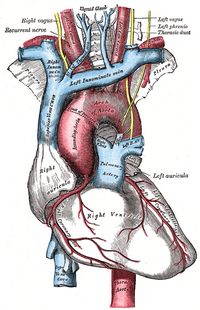|
The superior vena cava (SVC) is one of the great vessels, a large vein that receives the venous return from the upper portion of the body, including the head and neck, upper extremities, and chest, with some venous return from the posterior aspect of the abdomen. The exception is the venous return of the heart which comes back by way of the coronary veins and coronary sinus. The SVC originates at the junction of the left brachiocephalic vein with the right brachiocephalic vein. Its origin is described at the lower border of the first rib. The SVC ends at the cavoatrial junction, where it empties into the right atrium of the heart. It is here at the cavoatrial junction that anatomists describe a small horseshoe-shaped structure, the sinuatrial node or SA node, part of the conduction system of the heart. The length of the SVC is between 6 to 8 cm. There are many anatomical variations of the superior vena cava, as described here. The arch of the azygos vein empties into the posterior aspect of the SVC. The arch of the azygos vein receives the venous return of the azygos and hemiazygos venous systems, including the venous return of the posterior intercostal veins, and the ascending lumbar veins. Sources: |
|
| Back to MTD Main Page | Subscribe to MTD |
